Impact of Coal Mining on the Moisture Movement in a Vadose Zone in Open-Pit Mine Areas
Abstract
1. Introduction
2. Study Area and Methodology
2.1. General Characterization of the Study Region
2.2. Evolution of Groundwater Level during the Mining Period
2.3. Study Methodology
3. Field Investigation
3.1. Site Selection of the Field Investigation
3.2. Results of Field Investigation
3.2.1. The Lithologic Structure of the Vadose Zone
3.2.2. Water Content Change along a Shallow Soil Profile
4. Laboratory Tests
4.1. Test Items
4.1.1. Dry Soil Densities
4.1.2. Saturated Hydraulic Conductivity
4.1.3. Porosity of Soil
4.2. Results of Laboratory Tests
5. Numerical Simulation
5.1. Generalized and Numerical Model Setup
5.2. Governing Equations
5.3. Definite Conditions
6. Moisture Movement in a Vadose Zone during the Mining Period
- (1)
- Based on years of weather data and groundwater level variation characteristics, the moisture movement in the typical profile of the vadose zone was simulated during the coal mining period (2004–2016). The soil moisture movement in the intermediate vadose belt, close to the capillary water belt, during the continuous lowering of the groundwater level was analyzed under the mining conditions.
- (2)
- Based on the in situ test data, the moisture movement in the typical profile of the vadose zone during the monitoring period (from 11 September, 2017, to 9 March, 2018) was simulated. The influence of the groundwater level drop on the soil moisture contents in different vadose zone belts was analyzed, the maximum range of capillary rise was determined, and the critical depth to water, which can form a hydraulic relationship with the soil water belt, was simulated and predicted.
6.1. Groundwater Level and Vadose Zone Moisture Change during the Mining Period
6.2. Groundwater Level and Vadose Zone Moisture Change during the Monitoring Period
- (1)
- As the soil moisture content started to decrease significantly at a depth of 4 m below the surface, the area from the surface to a depth of 4 m could be classified as the soil moisture belt. In this belt, the variation in soil moisture content decreased with the increasing depth, and moisture distribution along the depth in this belt was different, as in Figure 9. Specifically, from November to March, as the temperature decreased, as suggested by Shen et al. [67], the temperature of the shallow vadose zone decreased until the soil moisture was frozen, during which time the soil moisture content was significantly reduced and more stable. In March, the moisture content of the soil moisture belt increased significantly, mainly due to the melting of frozen soil and surface snow. The difference in the moisture within a depth of 4 m convinced us that it is easily influenced by atmospheric change.
- (2)
- The area between the burial depths of 4–18.8 m was classified as the intermediate vadose belt. In this belt, the soil moisture content gradually decreased from 4 m to 9 m and remained basically stable from 10 m to 16 m, and its hydraulic connection with deep groundwater became weak. From the depth of 16 m to 19 m, the soil moisture content increased to a saturation state, making this area the capillary water belt. The soil moisture content was greatly affected by the variation in the capillary water belt’s height. At a depth of 16 m, when the height of the capillary water belt was reduced by 0.4 m, the soil moisture content dropped from 0.08 cm3/cm3 to 0.06 cm3/cm3, indicating that the soil moisture close to the capillary water belt shifted downwards as a whole with the lowering of the groundwater level. The soil moisture content of the intermediate vadose belt within the depths of 4.2 m to 16 m was close to the residual water content of the soil and was basically stable. It can be inferred that the change in groundwater level had little effect on the moisture movement of the shallow intermediate vadose belt or the soil moisture belt above the depth of 16 m. This depth can be logically regarded as the critical depth at which the dewatering of coal mining can be influenced.
- (3)
- The bottom of the vadose zone was a groundwater-supported capillary water belt with a soil moisture content of approximately 0.4 cm3/cm3. Affected by the drop in groundwater level, the height of the capillary water belt varied from 0.75 m to 1.2 m. Specifically, on 13 September, 2017, the groundwater level reached 20 m, and the height of the capillary water belt was 1.2 m. After the groundwater level was reduced by 1 m due to large-scale dewatering and drainage in the mining area, the height of the capillary water belt dropped by 0.4 m to approximately 0.8 m. On 20 January, 2018, the groundwater level continued to drop to 21.5 m, but the height of the capillary water belt stabilized at 0.75 m, a drop of 0.05 m. On 1 March, 2018, the groundwater level returned to 21 m, and the height of the capillary water belt increased to 0.78 m, an increase of 0.03 m. The difference between the variation of capillary water belts was caused by the groundwater level, which led the soil water content to decrease with the increasing depth, thereby causing the decrease of moisture in the vadose zone along the capillary height.
7. Discussion
8. Conclusions
- (1)
- The vadose zone in the Baorixile open-pit coal mine area has obvious zonality. The soil moisture belt was within a burial depth of around 4 m; the capillary water belt was between depths of about 0.75 m and approximately 1.2 m.
- (2)
- When the groundwater depth was greater than 8 m, it was no longer hydraulically connected with the surface’s soil moisture. The drop in groundwater level had a little effect on the moisture content of the vadose zone at depths of 16 m and above. The lower part of the intermediate vadose belt was significantly affected by the height variation in the capillary water belt. When the hydraulic connection between the soil and the water surface disappeared, the soil moisture content decreased by an average of about 15%.
- (3)
- During the long-term variation in moisture content in the middle and lower parts of the deep vadose zone caused by the mining-induced drop in groundwater level, the groundwater level dropped by an average of about 0.2 m per year, the height of the capillary water belt decreased by 1 m, and the intermediate vadose belt affected by the capillary water belt was within 3 m of the surface.
- (4)
- The groundwater level stabilized under long-term mining conditions and had little influence on the moisture movement in the vadose belt. In addition, the groundwater level change caused by the mining conditions mainly influenced the lower part of the intermediate vadose belt and the capillary water belt below the burial depth of 16 m but had little effect on the growth of shallow vegetation such as grasses and shrubs. Trees would be influenced initially but recovered to normal soon after the dewatering stops. As a whole, the vegetation was mainly affected by the changes in atmospheric precipitation at the upper boundary.
Author Contributions
Funding
Institutional Review Board Statement
Informed Consent Statement
Data Availability Statement
Acknowledgments
Conflicts of Interest
References
- Jiang, S.; Kong, X.; Ye, H.; Zhou, N. Groundwater dewatering optimization in the Shengli no. 1 open-pit coalmine, Inner Mongolia, China. Environ. Earth Sci. 2013, 69, 187–196. [Google Scholar] [CrossRef]
- Wang, W.; Zhu, T. Analysis of Hydrological Characteristics in Hulunbuir Grassland Area. Water Resour. Hydropower Northeast. China 2011, 29, 41–50. [Google Scholar]
- Gao, J. Research on Ecological Security Evaluation of Hulunbeier Grassland. Master’s Thesis, Chinese Academy of Environmental Sciences, Beijing, China, 2013. [Google Scholar]
- Zhang, D.; Li, W.; Lai, X.; Fan, G.; Liu, W. Research progress on the basic theory of water resources protection in coal mining in Northwest China. J. China Coal Soc. 2017, 42, 36–43. [Google Scholar]
- Li, H. Research on Distributed Water Circulation Model in Coal Mining Subsidence Area. Master’s Thesis, China Institute of Water Resources and Hydropower Research, Beijing, China, 2016. (In Chinese). [Google Scholar]
- Soni, A.K.; Manwatkar, B. Seepage Modeling for a Large Open Pit Coal Mine in India. Geotech. Geol. Eng. 2015, 33, 997–1007. [Google Scholar] [CrossRef]
- Rapantova, N.; Grmela, A.; Vojtek, D.; Halir, J.; Michalek, B.G. Ground water flow modelling ap-plications in mining hydrogeology. Mine Water Environ. 2007, 26, 264–270. [Google Scholar] [CrossRef]
- Zakir, H.; Islam, M.; Arafat, M.; Sharmin, S. Hydrogeochemistry and quality assessment of waters of an open coal minearea in a developing country: A case study from barapukuria, bangladesh. Int. J. Geosci. Res. 2013, 1, 20–44. [Google Scholar]
- Haque, E.; Reza, S.; Ahmed, R. Assessing the vulnerability of groundwater due to open pit coal mining using drasticmodel: A case study of phulbari coal mine, bangladesh. Geosci. J. 2018, 22, 359–371. [Google Scholar] [CrossRef]
- Park, J.; Kwon, E.; Chung, E.; Kim, H.; Battogtokh, B.; Woo, N.C. Environmental Sustainability of Open-Pit Coal Mining Practices at Baganuur, Mongolia. Sustainability 2019, 12, 248. [Google Scholar] [CrossRef]
- Monjezi, M.; Shahriar, K.; Dehghani, H.; Namin, F.S. Environmental impact assessment of open pit mining in Iran. Environ. Earth Sci. 2009, 58, 205–216. [Google Scholar] [CrossRef]
- Tiwary, R.K. Environmental Impact of Coal Mining on Water Regime and Its Management. Water Air Soil Pollut. 2001, 132, 185–199. [Google Scholar] [CrossRef]
- Zhao, L.; Ren, T.; Wang, N. Groundwater impact of open cut coal mine and an assessment methodology: A case study in NSW. Int. J. Min. Sci. Technol. 2017, 27, 861–866. [Google Scholar] [CrossRef]
- Liu, X.; Zhou, W.; Bai, Z. Vegetation coverage change and stability in large open-pit coal mine dumps in China during 1990–2015. Ecol. Eng. 2016, 95, 447–451. [Google Scholar] [CrossRef]
- Chu, D.; Zhu, Q.; Wang, J.; Zhao, X. Comparative analysis of ecological rucksack between open-pit and underground coal mine. Energy Procedia 2011, 5, 1116–1120. [Google Scholar]
- Liu, Z.; Yang, X. Assessment of the underground water contaminated by the leachate of waste dump of open pit coal mine based on RBF neural network. Adv. Mater. Res. 2012, 599, 272–277. [Google Scholar] [CrossRef]
- Zenkov, I.V.; Yuronen, Y.P.; Nefedov, B.N.; Zayats, V.V. Remote monitoring of ecological state of disturbed lands in the area of Trojanovo open pit coal mine in Bulgaria. Eurasian Min. 2017, 1, 38–41. [Google Scholar] [CrossRef]
- Wang, S.; Huang, J.; Yu, H.; Ji, C. Recognition of Landscape Key Areas in a Coal Mine Area of a Semi-Arid Steppe in China: A Case Study of Yimin Open-Pit Coal Mine. Sustainability 2020, 12, 2239. [Google Scholar] [CrossRef]
- Wu, Z.; Lei, S.; Lu, Q.; Bian, Z. Impacts of Large-Scale Open-Pit Coal Base on the Landscape Ecological Health of Semi-Arid Grasslands. Remote Sens. 2019, 11, 1820. [Google Scholar] [CrossRef]
- Dominguez-Haydar, Y.; Armbrecht, I. Response of Ants and Their Seed Removal in Rehabilitation Areas and Forests at El Cerrejón Coal Mine in Colombia. Restor. Ecol. 2010, 19, 178–184. [Google Scholar] [CrossRef]
- Ma, X.; Lu, Z.; Cheng, J. Ecological risk assessment of open coal mine area. Environ. Monit. Assess. 2008, 147, 471–481. [Google Scholar]
- Sun, Q.; Zhongke, B.; Yingui, C.; Miaomiao, X.; Xingding, H.; Yanzhu, J.; Yuanqing, L. Ecological risk assessment of land destruction in large open-pit mine. Trans. Chin. Soc. Agric. Eng. 2015, 31, 278–288. [Google Scholar]
- Xu, X.-C.; Gu, X.-W.; Wang, Q.; Gao, X.-W.; Liu, J.-P.; Wang, Z.-K.; Wang, X.-H. Production scheduling optimization considering ecological costs for open pit metal mines. J. Clean. Prod. 2018, 180, 210–221. [Google Scholar] [CrossRef]
- Li, X.; Lei, S.; Liu, F.; Wang, W. Analysis of Plant and Soil Restoration Process and Degree of Refuse Dumps in Open-Pit Coal Mining Areas. Int. J. Environ. Res. Public Health 2020, 17, 1975. [Google Scholar] [CrossRef]
- Mikhailov, V.G.; Koryakov, A.; Mikhailov, G.S. Ecological risk management in coal mining and processing. J. Min. Sci. 2015, 51, 930–936. [Google Scholar] [CrossRef]
- Miao, Z.; Marrs, R. Ecological restoration and land reclamation in open-cast mines in Shanxi Province, China. J. Environ. Manag. 2000, 59, 205–215. [Google Scholar] [CrossRef]
- Sawut, R.; Kasim, N.; Abliz, A.; Hu, L.; Yalkun, A.; Maihemuti, B.; Qingdong, S. Possibility of optimized indices for the assessment of heavy metal contents in soil around an open pit coal mine area. Int. J. Appl. Earth Obs. Geoinf. 2018, 73, 14–25. [Google Scholar] [CrossRef]
- Sawut, R.; Tiyip, T.; Abliz, A.; Kasim, N.; Nurmemet, I.; Sawut, M.; Tashpolat, N.; Ablimit, A. Using regression model to identify and evaluate heavy metal pollution sources in an open pit coal mine area, Eastern Junggar, China. Environ. Earth Sci. 2017, 76, 822. [Google Scholar] [CrossRef]
- Trefilova, O.V.; Grodnitskaya, I.D.; Efimov, D.Y. Dynamics of the ecological-functional parameters of replantozems on dumps of open-pit coal mines in Central Siberia. Eurasian Soil Sci. 2013, 46, 1253–1262. [Google Scholar] [CrossRef]
- Carabassa, V.; Ortiz, O.; Alcañiz, J.M. RESTOQUARRY: Indicators for self-evaluation of ecological restoration in open-pit mines. Ecol. Indic. 2019, 102, 437–445. [Google Scholar] [CrossRef]
- Ngugi, M.R.; Neldner, V.J.; Doley, D.; Kusy, B.; Moore, D.; Richter, C. Soil moisture dynamics and restoration of self-sustaining native vegetation ecosystem on an open-cut coal mine. Restor. Ecol. 2015, 23, 615–624. [Google Scholar] [CrossRef]
- Rahman, S. Soil moisture measurements and modeling at a geomorphically reclaimed coal mine in New Mexico. Master’s Thesis, The University of New Mexico, Albuquerque, NM, USA, 2014. [Google Scholar]
- Zhao, Z.; Shahrour, I.; Bai, Z.; Fan, W.; Feng, L.; Li, H. Soils development in opencast coal mine spoils reclaimed for 1–13 years in the West-Northern Loess Plateau of China. Eur. J. Soil Biol. 2013, 55, 40–46. [Google Scholar] [CrossRef]
- Philip, J.R.; De Vries, D.A. Moisture movement in porous materials under temperature gradients. Trans. Am. Geophys. Union 1957, 38, 222–232. [Google Scholar] [CrossRef]
- Milly, P.C.D. Climate, soil water storage, and the average annual water balance. Water Resour. Res. 1994, 30, 2143–2156. [Google Scholar] [CrossRef]
- Teddy Weiss, A.; Berman, D.S.; Lew, A.S.; Nielsen, J.; Potkin, B.; Swan, H.J.C.; Waxman, A.; Maddahi, J. Surface processes deposits and development on stress thallium-201 scintigraphy: A marker of severe and extensive coronary artery disease. J. Am. Coll. Cardiol. 1987, 9, 752–759. [Google Scholar]
- Song, Y. Study on Moisture Movement and Ecological Environmental Effects of the Vadose Zone in Shen-fu-Dongsheng Coal Mining Subsidence Area. Master’s Thesis, Chinese Academy of Geological Sciences, Beijing, China, 2007. [Google Scholar]
- Diamantopoulos, E.; Iden, S.C.; Durner, W. Inverse modeling of dynamic nonequilibrium in water flow with an effective approach. Water Resour. Res. 2012, 48, 3503. [Google Scholar] [CrossRef]
- Tarver, C.M.; Forbes, J.W.; Urtiew, P.A. Nonequilibrium Zeldovich-von Neumann-Doring theory and reactive flow modeling of detonation. Russ. J. Phys. Chem. B 2007, 1, 39–45. [Google Scholar] [CrossRef][Green Version]
- Šimůnek, J.; Van Genuchten, M.T. Modeling Nonequilibrium Flow and Transport Processes Using HYDRUS. Vadose Zone J. 2008, 7, 782–797. [Google Scholar] [CrossRef]
- Dvoryatkina, S.; Smirnov, E.; Lopukhin, A. New Opportunities of Computer Assessment of Knowledge Based on Fractal Modeling. US-China Foreign Lang. 2017, 15, 17. [Google Scholar] [CrossRef][Green Version]
- Karimi, M.A.; Karami, H.; Mahdipour, M. ANN modeling of water consumption in the lead-acid batteries. J. Power Sources 2007, 172, 946–956. [Google Scholar] [CrossRef]
- Richards, J.H. Root growth response to defoliation in two Agropyron bunchgrasses: Field observations with an improved root periscope. Oecologia 1984, 64, 21–25. [Google Scholar] [CrossRef]
- Barceló, J.; Poschenrieder, C. Fast root growth responses, root exudates, and internal detoxification as clues to the mechanisms of aluminium toxicity and resistance: A review. Environ. Exp. Bot. 2002, 48, 75–92. [Google Scholar] [CrossRef]
- Belmans, C.; Wesseling, J.; Feddes, R. Simulation model of the water balance of a cropped soil: SWATRE. J. Hydrol. 1983, 63, 271–286. [Google Scholar] [CrossRef]
- Major, J.; Rondon, M.; Molina, D.; Riha, S.J.; Lehmann, J. Nutrient Leaching in a Colombian Savanna Oxisol Amended with Biochar. J. Environ. Qual. 2012, 41, 1076–1086. [Google Scholar] [CrossRef]
- Du, Z.; Guo, Z.; Zhao, Y. Soil Structure and Permeability of Vadose Zone in Field Test Sites. Radiat. Prot. 2000, 20, 119–122. [Google Scholar]
- Xu, Y.; Zhao, G.; Ma, N.; Wang, L.; Peng, Y. A Review of the Factors Affecting the Water Transport Process in the Vadose Zone. J. North China Univ. Water Resour. Hydroelectr. Eng. 2019, 40, 37–41. [Google Scholar]
- Ma, C. Guide Book on Vadose Zone Hydrological Experiment; University of Geosciences press: Wuhan, China, 2013. [Google Scholar]
- Wang, Q. Measurement of Soil Bulk Density and Saturated Moisture Content in Old Sand Fields. J. Gansu Agric. Sci. Technol. 2016, 8, 46–49. [Google Scholar]
- Yao, Y.; Shao, M. Effect of Determination Time on Saturated Soil Hydraulic Conductivity under a Constant Head Method. Chin. J. Soil Sci. 2015, 46, 327–333. [Google Scholar]
- Pan, G. Study on the Temperature Effect of Mechanical and Thermodynamic Parameters of Soil Moisture in the Lake Shoal of Mu Us. Master’s Thesis, Chang’an University, Xi’an, China, 2016. [Google Scholar]
- Van Genuchten, M.T. A Closed-form Equation for Predicting the Hydraulic Conductivity of Unsaturated Soils. Soil Sci. Soc. Am. J. 1980, 44, 892–898. [Google Scholar] [CrossRef]
- Liu, P.S.; Hao, W.P.; Li, J.; Jia, Z. Study on curve fitting features of soil moisture and root system’s dynamic distribution in alfalfa grassland in drought areas of southern Ningxia. J. Agric. Univ. Hebei 2011, 34, 29–34. [Google Scholar]
- Niswonger, R.G.; Panday, S.; Ibaraki, M. MODFLOW-NWT, a Newton formulation for MOD-FLOW-2005. US Geol. Surv. Tech. Methods 2011, 6, 44. [Google Scholar]
- Kim, N.W.; Chung, I.M.; Won, Y.S.; Arnold, J.G. Development and application of the integrated SWAT–MODFLOW model. J. Hydrol. 2008, 356, 1–16. [Google Scholar] [CrossRef]
- White, M.D.; Oostrom, M. STOMP Subsurface Transport over Multiple Phases, Version 4.0, User’s Guide; Pacific Northwest National Lab: Richland, WA, USA, 2006. [Google Scholar]
- Kolditz, O.; Bauer, S.; Bilke, L.; Böttcher, N.; Delfs, J.O.; Fischer, T.; Görke, U.J.; Kalbacher, T.; Kosakowski, G.; McDermott, C.I.; et al. OpenGeoSys: An open-source initiative for numerical simulation of thermo-hydro-mechanical/chemical (THM/C) processes in porous media. Environ. Earth Sci. 2012, 67, 589–599. [Google Scholar] [CrossRef]
- Oldenburg, C.M.; Unger, A.J.A. Coupled vadose zone and atmospheric surface-layer transport of carbon dioxide from geologic carbon sequestration sites. Vadose Zone J. 2004, 3, 848–857. [Google Scholar] [CrossRef]
- Radcliffe, D.E.; Simunek, J. Soil Physics with Hydrus: Modeling and Applications; CRC Press: Boca Raton, FL, USA, 2018. [Google Scholar]
- Silva, J.A.K.; Šimůnek, J.; McCray, J.E. A Modified HYDRUS Model for Simulating PFAS Transport in the Vadose Zone. Water 2020, 12, 2758. [Google Scholar] [CrossRef]
- Šimunek, J.; Van Genuchten, M.T.; Šejna, M. HYDRUS: Model use, calibration, and validation. Trans. ASABE 2012, 55, 1263–1274. [Google Scholar]
- Mualem, Y. A new model for predicting the hydraulic conductivity of unsaturated porous media. Water Resour. Res. 1976, 12, 513–522. [Google Scholar] [CrossRef]
- Assouline, S.; Tessier, D.; Bruand, A. A conceptual model of the soil water retention curve. Water Resour. Res. 1998, 34, 223–231. [Google Scholar] [CrossRef]
- Rajkai, K.; Kabos, S.; van Genuchten, M. Estimating the water retention curve from soil properties: Comparison of linear, nonlinear and concomitant variable methods. Soil Tillage Res. 2004, 79, 145–152. [Google Scholar] [CrossRef]
- Zhang, Y. Study on Inversion Method for Heterogeneous Vadose Zone’s Hydraulic Parameters. Master’s Thesis, China University of Geosciences, Wuhan, China, 2014. [Google Scholar]
- Shen, S.L.; Wu, Y.X.; Xu, Y.S.; Hino, T.; Wu, H.-N. Evaluation of hydraulic parameters from pumping tests in multiaquifers with vertical leakage in Tianjin. Comput. Geotech. 2015, 68, 196–207. [Google Scholar] [CrossRef]
- Hu, M.J.; Zhang, C.Y.; Cui, X.; Kun-Yao, L.; Jian-Jian, T. Experimental study on capillary rise and influencing factors in calcareous sand. Rock Soil Mech. 2019, 4, 4157–4163. [Google Scholar]
- Zhang, H.J. Gradient Effect of the Mining of Baorixile Open Pit Mine on the Physical and Chemical Properties of Grassland Soil. Master’s Thesis, China University of Geosciences, Wuhan, China, 2019. (In Chinese). [Google Scholar]
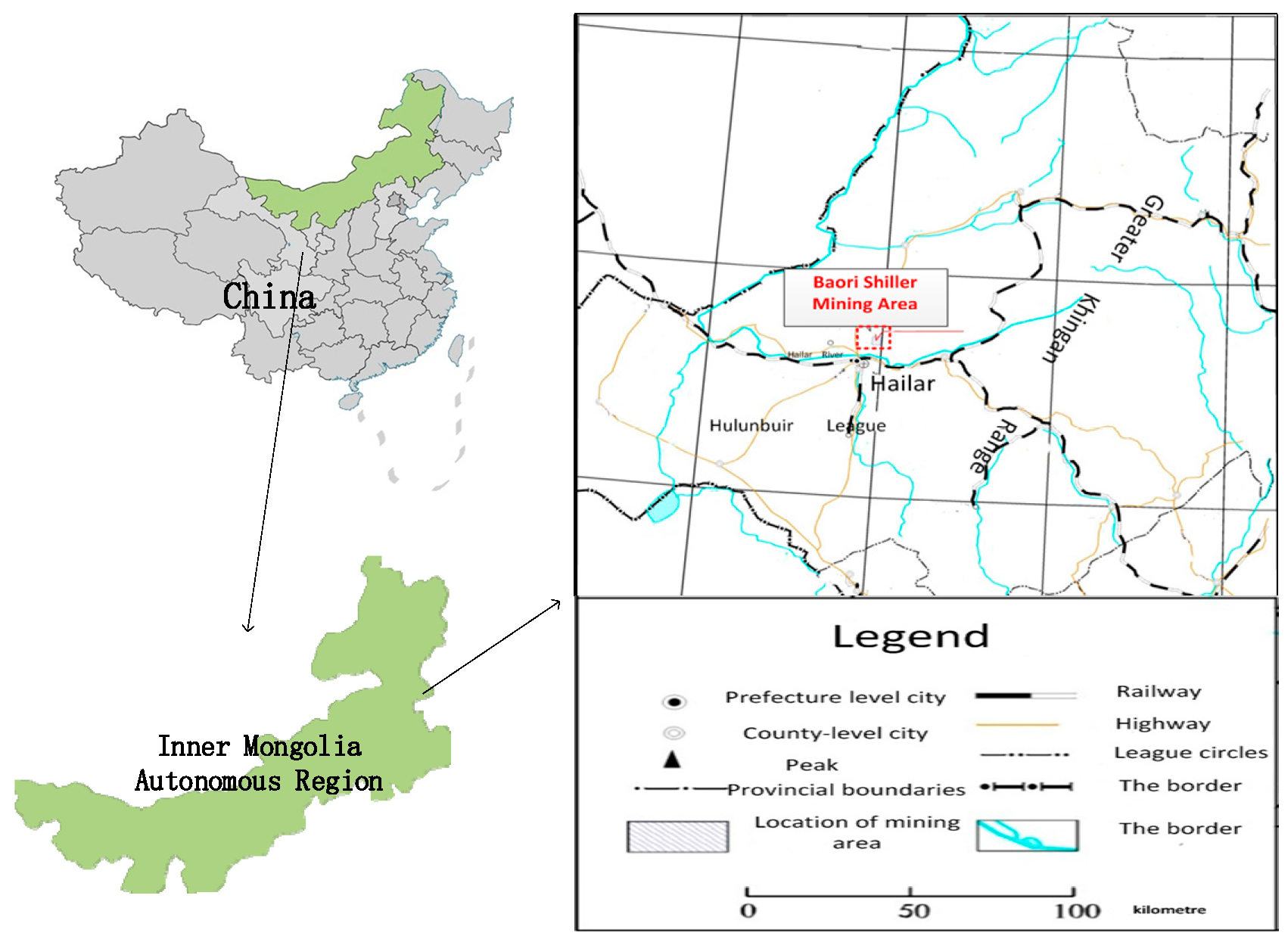
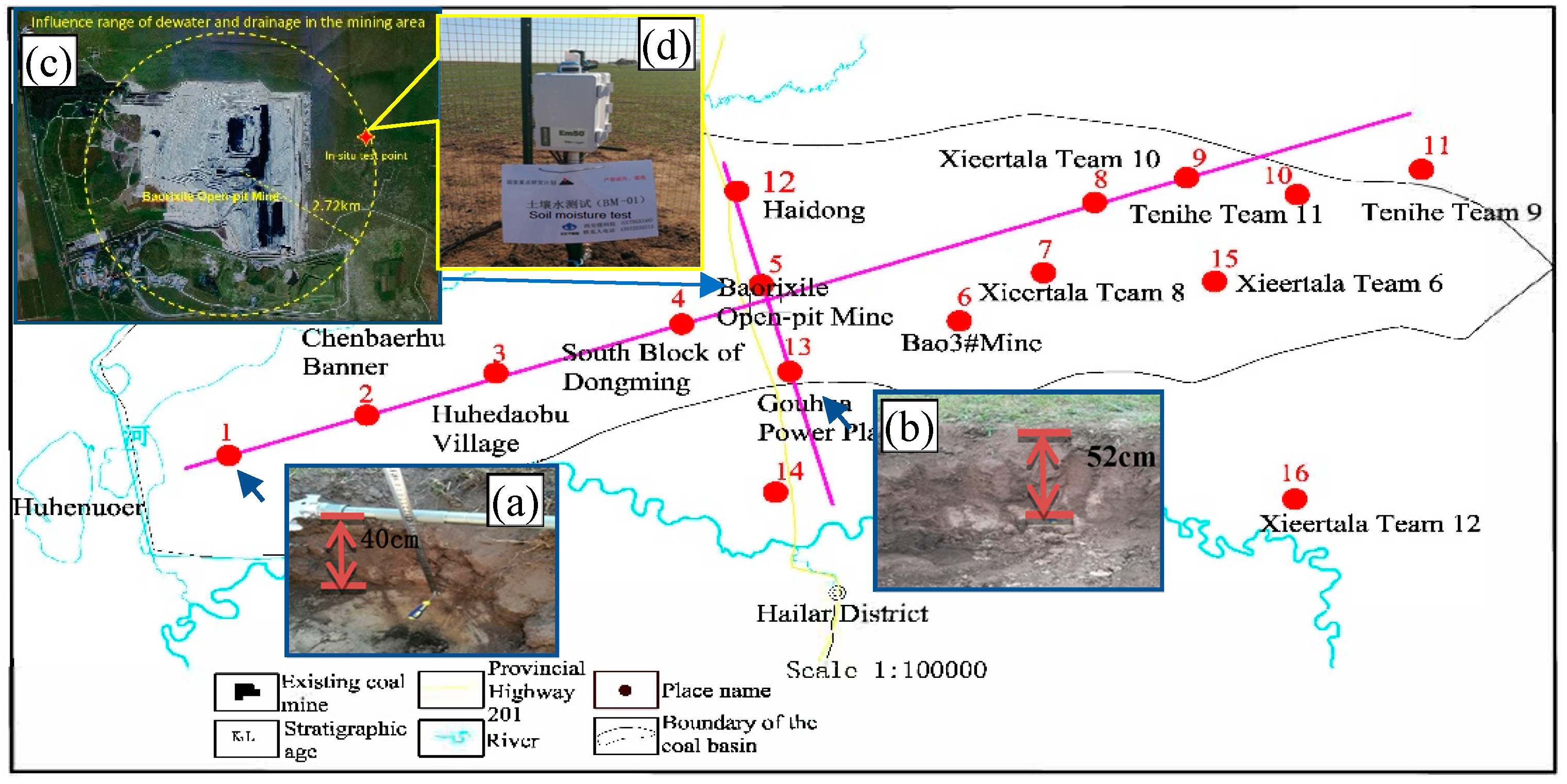
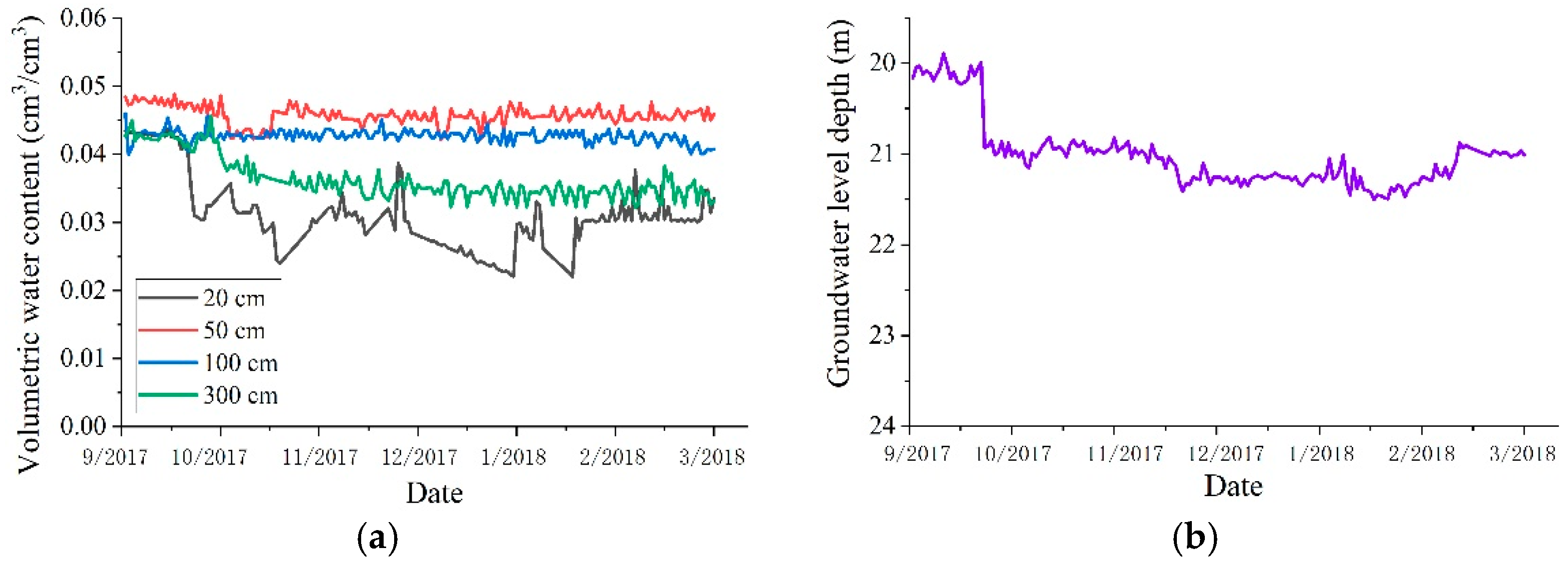


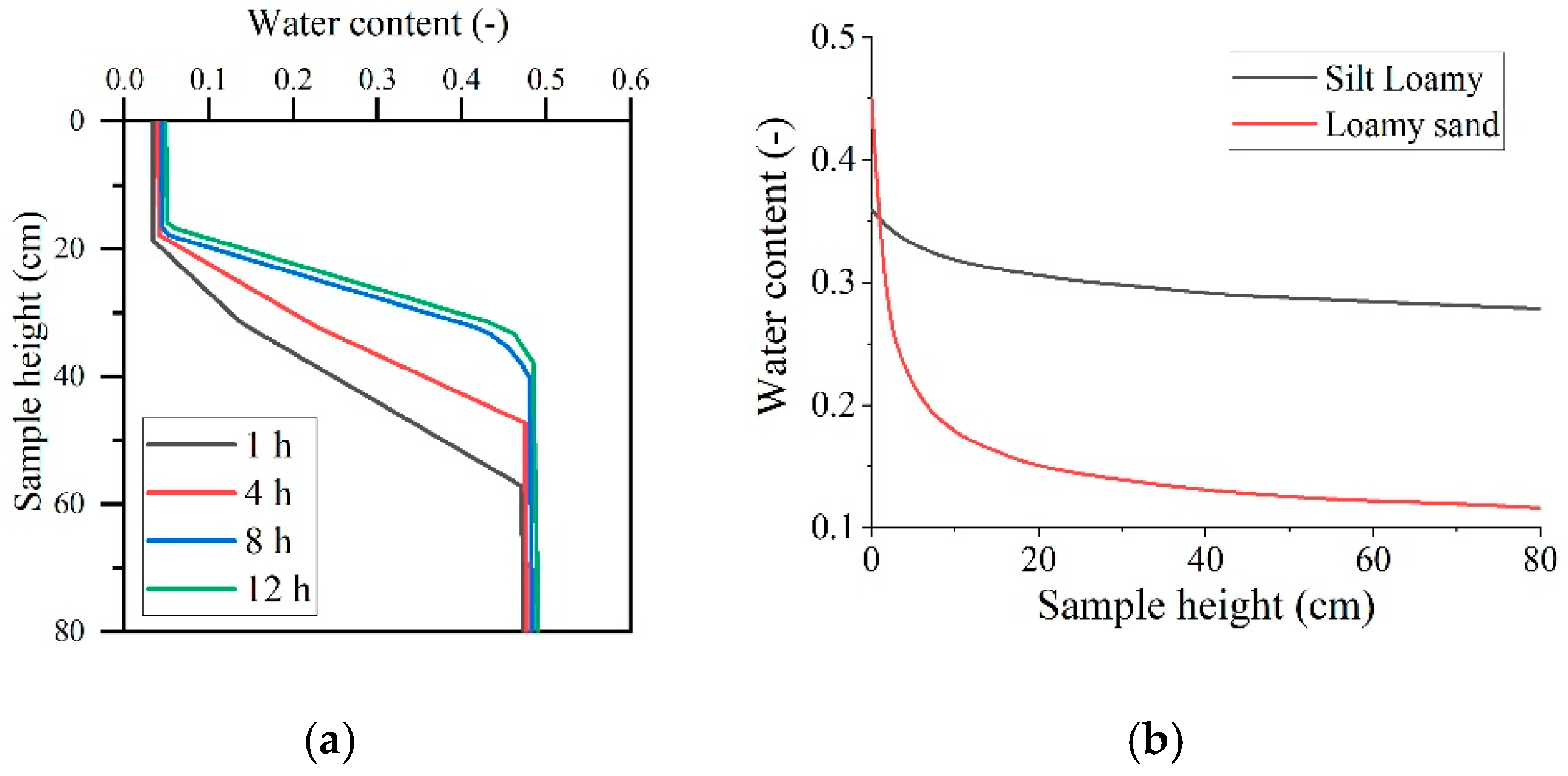
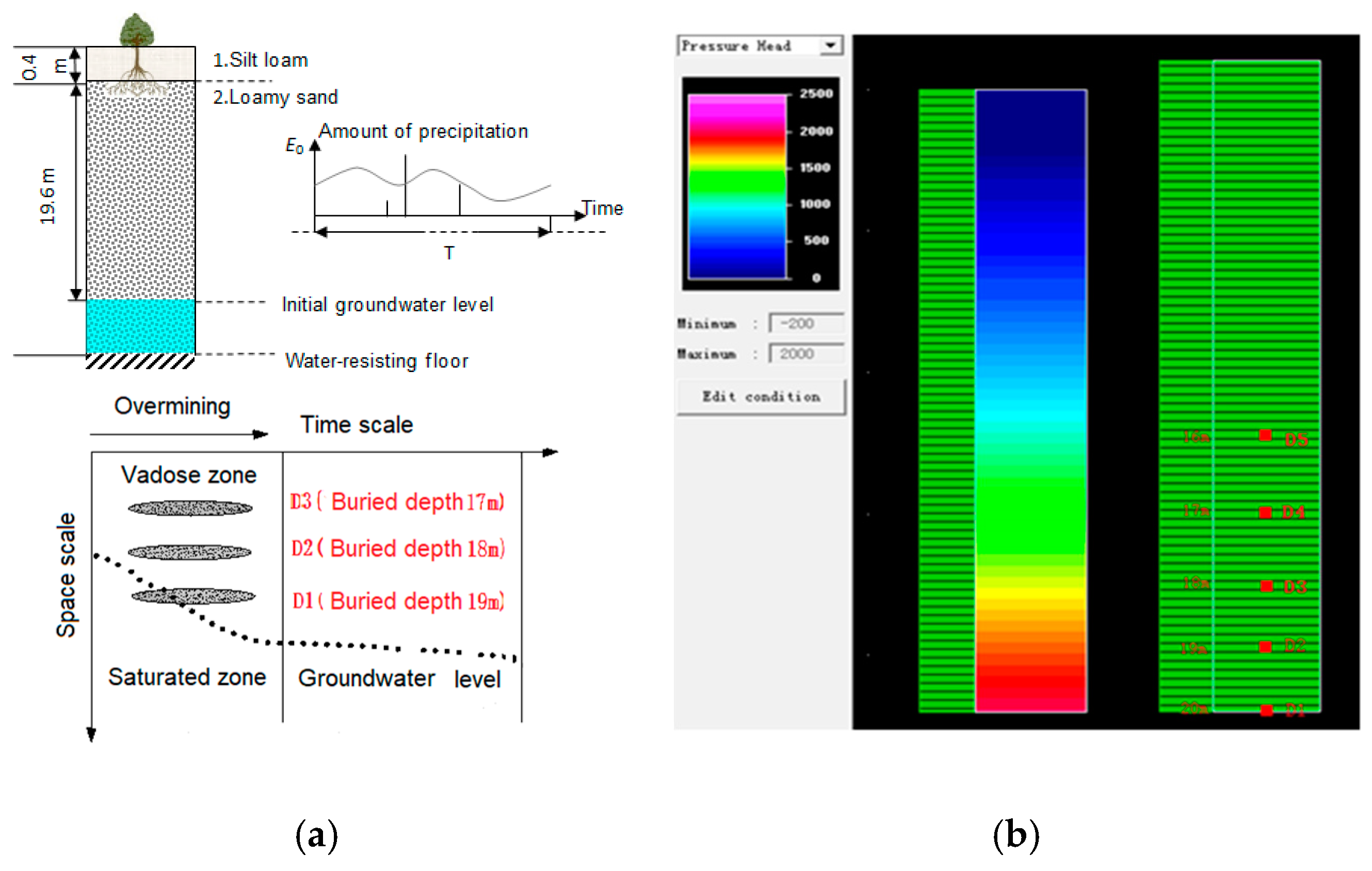
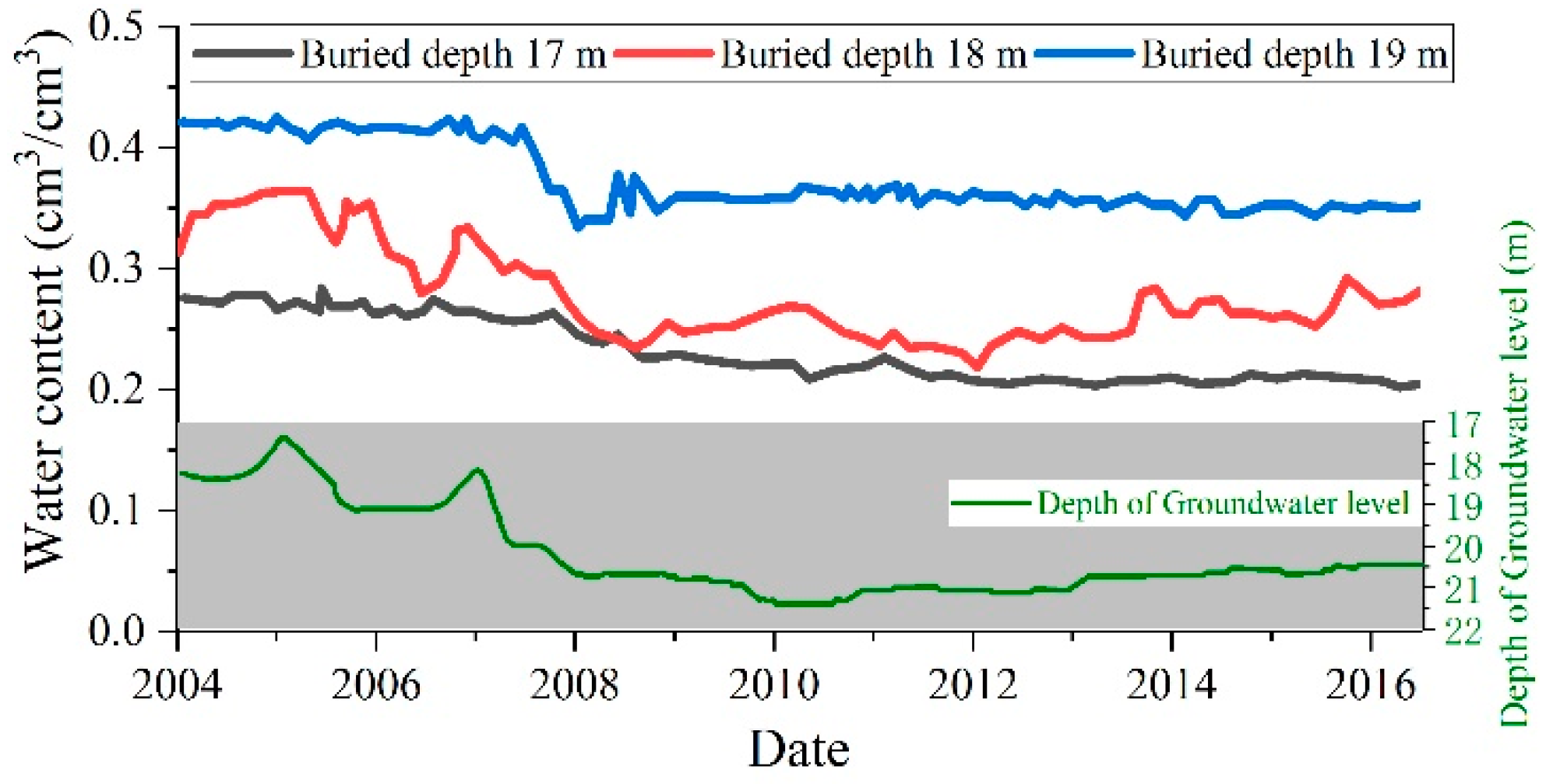
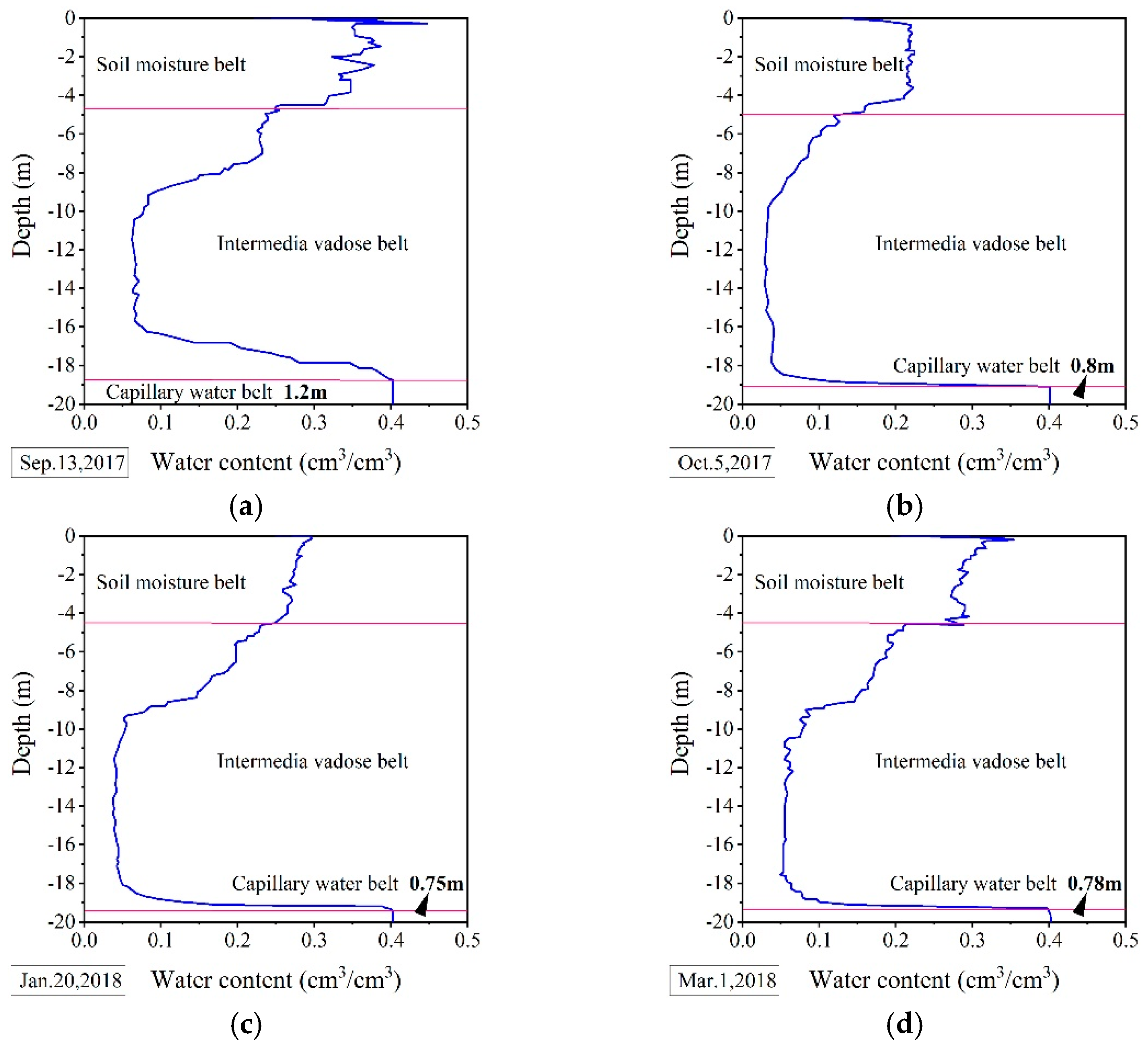
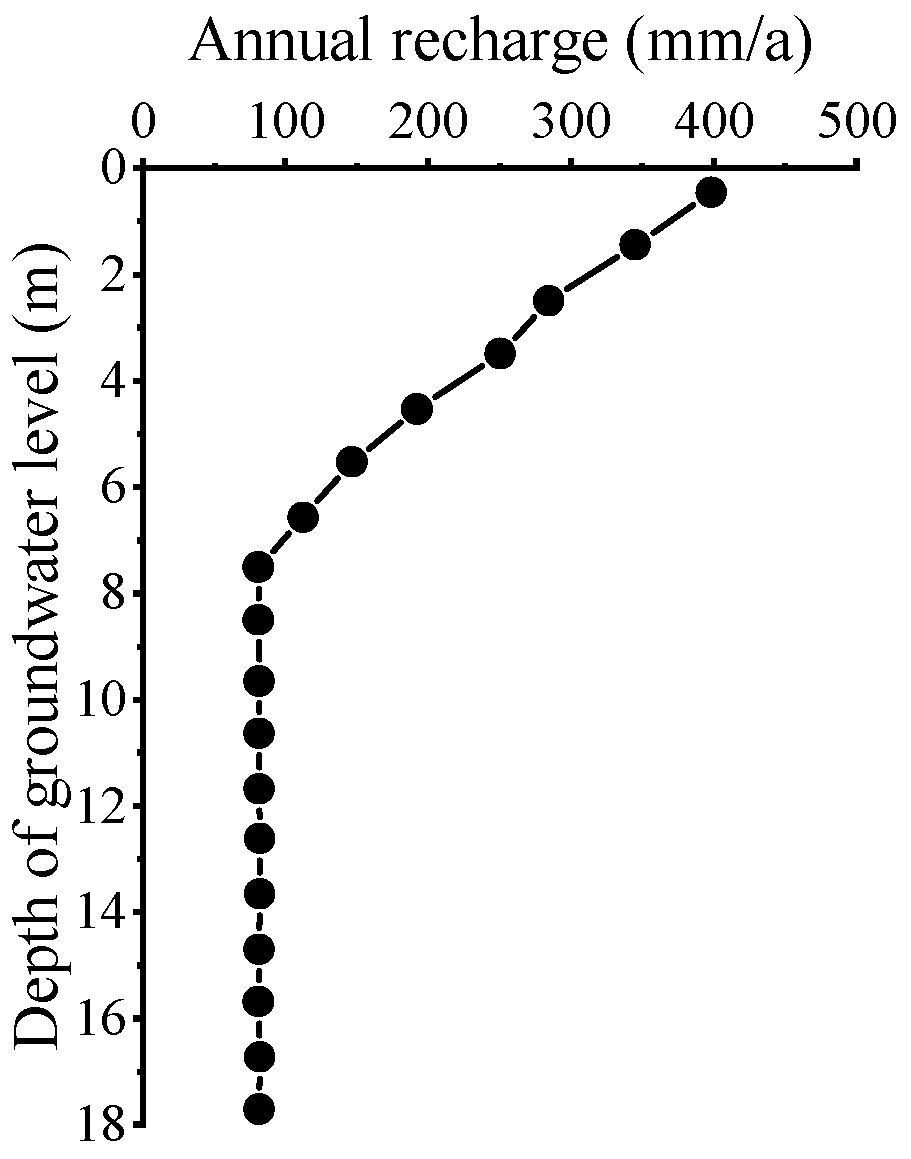
| Soil Depth /cm | Residual Moisture Content | Saturated Moisture Content | Empirical Parameter α/cm−1 | Curve Shape Parameter n | Hydraulic Conductivity |
|---|---|---|---|---|---|
| 0–40 | 0.043 | 0.4753 | 0.03028 | 1.39 | 9.623 |
| 40–2000 | 0.061 | 0.4214 | 0.005692 | 2.07 | 362.2 |
| Time Variation (s) | Initial Water Head (cm) | Final Water Head (cm) | Correction | ||||
|---|---|---|---|---|---|---|---|
| Silt loam | 8.15 | 100 | 73 | 1.08 × 10−4 cm/s | 0.988 | 1.08 × 10−4 cm/s | 1.11 × 10−4 (=9.623 cm/d) |
| 7.63 | 100 | 71 | 0.94 × 10−4 cm/s | 0.988 | 0.93 × 10−4 cm/s | ||
| 8.99 | 80 | 67 | 1.18 × 10−4 cm/s | 0.976 | 1.16 × 10−4 cm/s | ||
| 9.03 | 80 | 65 | 1.13 × 10−4 cm/s | 0.988 | 1.12 × 10−4 cm/s | ||
| 9.47 | 50 | 37 | 1.09 × 10−4 cm/s | 1.012 | 1.09 × 10−4 cm/s | ||
| 8.51 | 50 | 36 | 0.97 × 10−4 cm/s | 0.988 | 0.96 × 10−4 cm/s | ||
| Loamy sand | 6.24 | 100 | 62 | 4.55 × 10−6 cm/s | 0.976 | 4.53 × 10−3 cm/s | 4.19 × 10−3 (=362.2 cm/d) |
| 6.03 | 100 | 64 | 4.25 × 10−6 cm/s | 0.988 | 4.25 × 10−3 cm/s | ||
| 7.15 | 80 | 56 | 4.67 × 10−6 cm/s | 0.976 | 4.66 × 10−3 cm/s | ||
| 6.22 | 80 | 55 | 4.19 × 10−6 cm/s | 0.988 | 4.18 × 10−3 cm/s | ||
| 6.35 | 50 | 29 | 4.26 × 10−6 cm/s | 0.988 | 4.25 × 10−3 cm/s | ||
| 5.89 | 50 | 27 | 4.63 × 10−6 cm/s | 1 | 4.63 × 10−3 cm/s |
| Time | 13 September 2017 | 5 October 2017 | 20 January 2018 | 1 March 2018 |
|---|---|---|---|---|
| Groundwater depths/m | 20 | 21 | 21.5 | 21 |
| Height of capillary water belt/m | 1.2 | 0.8 | 0.75 | 0.78 |
Publisher’s Note: MDPI stays neutral with regard to jurisdictional claims in published maps and institutional affiliations. |
© 2021 by the authors. Licensee MDPI, Basel, Switzerland. This article is an open access article distributed under the terms and conditions of the Creative Commons Attribution (CC BY) license (https://creativecommons.org/licenses/by/4.0/).
Share and Cite
Lian, H.; Yi, H.; Yang, Y.; Wu, B.; Wang, R. Impact of Coal Mining on the Moisture Movement in a Vadose Zone in Open-Pit Mine Areas. Sustainability 2021, 13, 4125. https://doi.org/10.3390/su13084125
Lian H, Yi H, Yang Y, Wu B, Wang R. Impact of Coal Mining on the Moisture Movement in a Vadose Zone in Open-Pit Mine Areas. Sustainability. 2021; 13(8):4125. https://doi.org/10.3390/su13084125
Chicago/Turabian StyleLian, Huiqin, Haiyang Yi, Yi Yang, Bin Wu, and Rui Wang. 2021. "Impact of Coal Mining on the Moisture Movement in a Vadose Zone in Open-Pit Mine Areas" Sustainability 13, no. 8: 4125. https://doi.org/10.3390/su13084125
APA StyleLian, H., Yi, H., Yang, Y., Wu, B., & Wang, R. (2021). Impact of Coal Mining on the Moisture Movement in a Vadose Zone in Open-Pit Mine Areas. Sustainability, 13(8), 4125. https://doi.org/10.3390/su13084125






